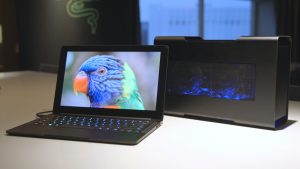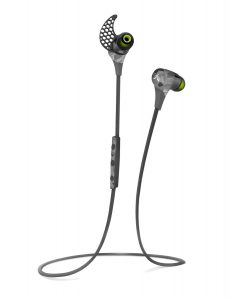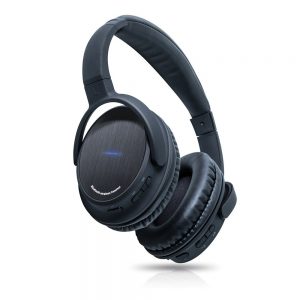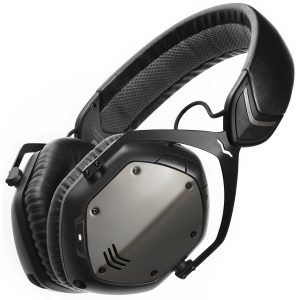What is an External Graphics Dock?
Not everyone who likes to play video games has the time, money, or know-how to build their own gaming PC. These people will more often than not opt to get a gaming laptop instead, which with their high cost and TDP/wattage-limited graphics solutions prove unsatisfactory for high intensity gaming. If not a gaming laptop, then they do what they can with their thin & light notebook with integrated graphics that, while great for portability, can not run games very well at all. Using an external graphics dock you can get the best of both worlds! There is minimal assembly required, and you can have your thin and light laptop to bring to class or to work, then when you get home plug into your external graphics dock and have all the gaming horsepower and display outputs you need.
Sounds Great! How Do These External Graphics Docs Work, Then?
The most basic eGPU dock
The basic concept of an external graphics dock is this: take a regular desktop Graphics Card, plug it into a PCIe slot in a dock, get power to the dock and the Graphics card, then plug that dock into your laptop. After installing the right drivers and performing two or three restarts, hark! High frame rates at high settings are coming your way. The internal GPU is completely bypassed and data is sent from the laptop to the GPU to an external display, and in some cases back to the laptop to power its own internal display. The graphics card will have to be purchased separately, and to see a sizable difference in performance over a dedicated laptop GPU you will be looking at around $200 for that card on top of the cost of the dock. Each commercially available dock has their own benefits and drawbacks, but all of them share some basic properties. They can all accept any single or dual-slot GPU from AMD or Nvidia (cooler size permitting), and have at least two 6+2-pin power connectors to power the graphics card. Along with the GPU support, docks usually also add at least four USB ports to connect peripherals similar to the laptop docks of olde.
So What Are The Performance Numbers Really Like?
In general, performance loss over using that same GPU in a real desktop is 10-15%. This can be due to a reduced bandwidth over the connection to the laptop, or due to bottlenecking from less powerful laptop CPUs. However, even over a dedicated laptop GPU the increase in performance when using an external one is roughly double. Here’s a few benchmarks of recent AAA titles, courtesy of TechSpot. Listed from bottom to top, each graph has performance of the internal GPU, the Graphics Amplifier with a desktop GPU, and that same GPU in a regular desktop PC.
Let’s Take A Look At What is Available Today:
Alienware Graphics Amplifier (MSRP $199):

Pros – Relatively inexpensive, High bandwidth interface, Good airflow, PSU is user upgradeable
Cons – Only works for Alienware machines (R2 & up), Uses proprietary cable, Requires shutdown to connect / disconnect
Razer Core (MSRP $499):

Pros – Universal Thunderbolt 3 interface, Adds ethernet jack, Sturdy aluminum construction, Small size
Cons – High cost, Compatibility list with non-Razer computers is short
MSI GS30 Shadow:

Pros: User upgradeable PSU, Includes support for internal 3.5″ drive, Has integrated speakers
Cons: Only works for one machine, Huge footprint, Dock cannot be purchased separately
Final Thoughts
After seeing all the facts, does using an eGPU sound like the solution for you? If none of the options available sound perfect right now, don’t fret. As the popularity of eGPUs grows, more companies will inevitably put their hats into the ring and make their own solutions. Prices, form factors, and supported laptops will continue changing and improving as time goes on.



 Premium channels like MTV, Oxygen, NHL Network, FXM, GOLF, and NBA TV are all included in the 100 channel package. If you want to keep up on Game of Thrones on HBO, you can do that too, but you’ll be adding an extra $5 to your monthly cost. One of the big draws to this service is that they offer “100-plus premium channels … [not] the junk that nobody wants” says AT&T director Randall Stephenson. This claim is bolstered by the addition of more channels provided with their recent acquisition of another major cable company, Time Warner. While this all seems well and good, there are a few downsides to AT&T’s new service. Like any streaming service, there is a limit to the amount of people who can watch, and the limit here is pitifully low at only two concurrent users. This would prove difficult for a four person family if each member wanted to watch their own shows. There are also some vague issues with availability for local channels and regional live sports channels. No set top box is needed for the connection, and all you need is a broadband internet connection to get started, so this is an attractive offering for college students.
Premium channels like MTV, Oxygen, NHL Network, FXM, GOLF, and NBA TV are all included in the 100 channel package. If you want to keep up on Game of Thrones on HBO, you can do that too, but you’ll be adding an extra $5 to your monthly cost. One of the big draws to this service is that they offer “100-plus premium channels … [not] the junk that nobody wants” says AT&T director Randall Stephenson. This claim is bolstered by the addition of more channels provided with their recent acquisition of another major cable company, Time Warner. While this all seems well and good, there are a few downsides to AT&T’s new service. Like any streaming service, there is a limit to the amount of people who can watch, and the limit here is pitifully low at only two concurrent users. This would prove difficult for a four person family if each member wanted to watch their own shows. There are also some vague issues with availability for local channels and regional live sports channels. No set top box is needed for the connection, and all you need is a broadband internet connection to get started, so this is an attractive offering for college students.


